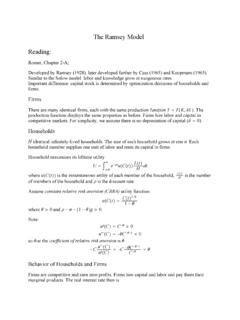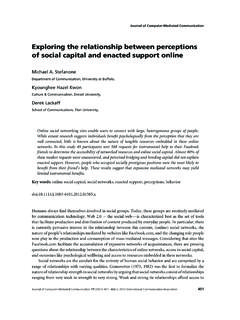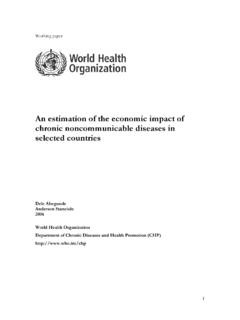Transcription of The Solow Growth Model - Jan Fidrmuc's Home Page
1 The Solow Growth ModelReading:Romer, Chapter 1;Robert E. Lucas Jr., Why Doesn t Capital Flow from Rich to Poor Countries? AERP apers and Proceedings, 92-96, 1990;Martin Feldstein and Charles Horioka, Domestic Savings and International CapitalFlows, Economic Journal, 314-329, , Romer and Weil. A Contribution to the Empirics of Economic Growth , Quarterly Journal of Economics 107 (2), 1992, Facts of Economic GrowthLittle Growth in per-capita output before the Industrial Revolution:technological progressand productivity gains translated into population Growth rather than output Growth ; mostpeople attained little more than subsistence income throughout most of human Growth in GDP per capita: 0% in Western Europe and India during the firstmillenium, in Western Europe and in India between 1000 and Growth was similarly 0% during the first millenium and in WesternEurope and in India between 1000 and 1820 [Maddison, 2001].
2 World population grew on average less than per year between 1 and 1750 [Livi-Baci,A Concise History of World Population, Blackwell, 1997].Rapid Growth in output and standard of living since the Industrial Revolution:per-capitaincomes increased 50-300 fold in Western Europe and the US during the past 200 Great Divergence:little difference in per capita incomes across countries until theIndustrial Revolution, on-going divergence since then. The ratio between per capitaincomes in the richest regions (US, Canada and New Zealand) and the poorest ones(Africa) was 3 in 1820; this ratio has increased to 20 by 1998 [Maddison, 2001].By the end of the first millenium, China and India were both richer and moretechnologically advanced then Europe. By 1700, the core areas of Europe and Asia hadsimilar consumption levels and overall wellbeing.
3 Subsequently, Industrial Revolution tookplace in Europe whose Growth has far outpaced that of China and explanations for divergence and reversal or roles: Landes (The Wealth and Poverty of Nations: Why Some Are So Rich and Some Are SoPoor, 1999): European nations embracedinsitutionsthat encouraged entrepreneurship,invention and technological progress. Competition between nations created a strongincentive to utilize technological progress to gain a competitive (and military)advantage. The latter was not the case in China, India or the Ottoman empire whichwere subject to political hegemony and (initially) free from an outside threat. Pomeranz (The Great Divergence: China, Europe, and the Making of the ModernWorld Economy, 2001): Europe benefited from having convenient sources of coal thatreplaced timber at the eve of the Industrial Revolution.
4 Because of trade andcolonization of the New World, Europe gained a new source of primary products. Thisallowed increased population Growth in Europe and, by releasing labor fromaggriculture, facilitated its specialiazation in manufacturing . Growth often varies considerably over time:the same country may experience growthaccelerations and slowdowns: Mexico, Soviet Union/Russia, miracles South Korea, Taiwan, Singapore, Hong Kong, and more recently Chinaand Botswana and Growth disasters Argentina (one of the richest countries in 1900) andSub-saharan differences in Growth rates and output levels are correlated with differencesin other measures of well-being: nutrition, literacy, infant mortality, life expectancy, (1988):Once one starts to think about economic Growth , it is hard to think aboutanything sources of Growth : factor accumulation: physical capital, labor and human capital; technological progress.
5 Economics initially focused on factor accumulation ( Solow and Ramseymodels of Growth ), then on technological progress (endogenous Growth models). Morerecently, institutional economics emphasises the importance of Solow Growth ModelRobert Solow (1956), Swan (1956).AssumptionsSavings and investment decisions are exogenous (no individual optimization). Factoraccumulation and technological Growth are also function, with physical capitalK, laborLand knowledge or technologyA:Y t F K t ,A t L t Time affects output only throughK,LandA. Technology islabor-augmenting:ALiseffective labor. Land and natural resources are ignored (not considered among factors ofproduction).Constant returns to scale (CRTS):F cK,cAL cF K,AL for anyc : Cobb-Douglas functionY K AL 1 displays CRTS: cK cAL 1 c K c1 AL 1 cK AL 1 Because of CRTS, we can expressY t inintensive form,takingc 1AL:FKAL,1 1 ALF K,AL or, denotingk KAL,y YALandf k F k,1 , we can relate output per unit of effectivelabor as a function of capital per unit of effective labor:y f k.
6 The intensive-form production function is assumed to have the following properties:f 0 0f k 0f k 0and Inada conditions:limk 0f k limk f k 0 Example: Cobb-Douglas function:Y K AL 1 which translates intoy k .Diminishing marginal product of capital:f k k 1 0f" k 1 k 2 0 Note thatf k Y K: Y K K 1 AL 1 K 1 AL 1 k 1 Evolution of Effective LaborLabor and knowledge grow at constant exogenous ratesnandg:L t nL t A t gA t Note that the Growth rate of a variable equals the rate of change of its log:dlnL t dt dlnL t dL t dL t dt 1L t L t L t L t nUsing this, and taking the initial value ofL t as given:dlnL t dt ndlnL t ndtlnL 1 lnL 0 nTherefore,lnL 1 lnL 0 nlnL 2 lnL 1 n lnL 0 t lnL 0 ntSimilarly,lnA t lnA 0 gtHence, for given initial levels ofLandA, this implies that labor and knowledge growexponentially:L t L 0 entA t A 0 egtDynamics of CapitalAssume constant and exogenous savings rate,s, ( not a result of individual optimizationdecision) and constant depreciation rate of capital.
7 K t sY t K t Dynamics of capital per unit of effective labor,k KAL:k t K t A t L t K t A t L t 2 A t L t A t L t K t A t L t K t A t L t L t L t A t A t sY t K t A t L t k t n g sf k t n g k t The first term,sf k t , is the actual investment in physical capital per unit of effectivelabor. The second term, n g k t ,istheeffectivedepreciation of capital per unit ofeffective (equilibrium) occurs at such value of capital per effective labor,k ,wherek t 0:sf k n g k , investment equals effective depreciation andkremains constant over time. Becauseof the Inada conditions, there is only a single value ofk of aggregate variables in the steady state: effective labor,AL, grows at rate n g . Capital grows at the same rate (note thatK ALk , withk constant). Because ofCRTS, aggregate output grows at rate n g.
8 Output per unit of effective labor,y, is constant. Capital per worker,KL, and output perworker,YL, Growth pathIn the steady state, all variables grow at constant rates: Capital per unit of effective labor,k : constant; Labor and technology grow at ratesnandg, respectively; Capital,K ALkgrows at rate n g ; Because of CRTS, output,Y,alsogrowsatrate n g ; Capital per worker,KL, and output per worker,YL, , the equilibrium (steady state) rate of Growth of output per capita is determined bythe rate of technological progress Statics: Change in the Savings RateRecall: in the steady state:sf k n g k The savings rate,s, is a key parameter of the Solow Model . An increase insimplies higheractual investment;kgrows until it reaches its new (higher) steady-state value. In thetransition to the new steady state, the rate of Growth of output per worker the new steady state is attained, all variables grow again at the same rates as before;output per worker again grows at the rate of Growth of technological progress,g,whichisindependent ofs.
9 An increase in the savings rate only leads to a temporary increase in thegrowth rate of output per worker (but a permanent rise in the level of capital per worker andoutput per worker).In the Solow Model , only changes in technological progress have permanentgrowth effects,all other changes havelevel on ConsumptionHousehold welfare depends on consumption rather than of output that is consumed is 1 s so thatc 1 s f k . Whensincreases,cinitially falls but then rises gradually as output per worker,f k , increases. Eventually, itmay be greater or smaller than before the change the steady state (usingsf k n g k )c f k sf k f k n g k How do changes in the savings rate affect consumption? Noting thatk depends onsaswell asn,g,and : c s f k s,n,g, n g k s,n,g, last term, k s,n,g, s, is always positive: an increase in the savings rate always translatesinto a higherk.
10 The impact of changes in the savings rate on consumption depends on the sign of f k n g , whether the marginal product of capital,f k , exceeds n g . Because of the properties that we assumed to hold for the production function,f k exceeds n g for small values ofkand falls short of it for large values of capital: The highest possible level of consumption is attained at thelevel ofk such that c s 0orf k n g Note: in the Solow Model , households/firms do not make any optimization decisions; thesavings rate is exogenous. Therefore, there is no reason to expect the golden-rule level ofk to prevail rather than some other level ofk .Effect on OutputEffect on steady-state output,y : y s f k k s,n,g, sIn the steady statek 0, therefore we can use the following propertysf k s,n,g, n g k s,n,g.






